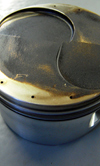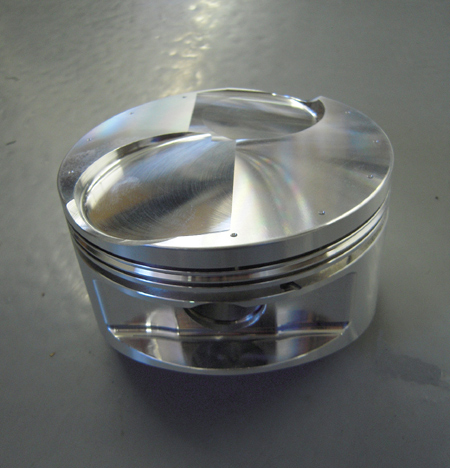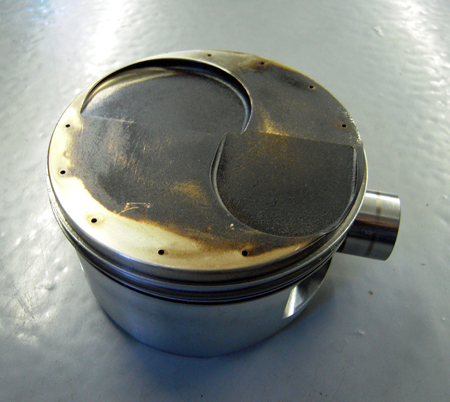Historic piston use in the midget engine
 Dan Esslinger, President of Esslinger Engineering has been building Midget engines since 1990 - "So I guess we're 20-ish years into this thing," he says. In that time, Esslinger Engineering has gone through perhaps 30 iterations of pistons, "That's been due to bore size change, different strokes, different rod lengths, valve locations, things of that ilk," he says. "If you change one, it all changes.
Dan Esslinger, President of Esslinger Engineering has been building Midget engines since 1990 - "So I guess we're 20-ish years into this thing," he says. In that time, Esslinger Engineering has gone through perhaps 30 iterations of pistons, "That's been due to bore size change, different strokes, different rod lengths, valve locations, things of that ilk," he says. "If you change one, it all changes.
"Typically we use JE three-ring pistons because they are local (less than an hour away from Esslinger's shop) and they do an outstanding job. They work with us and turn stuff around in a hurry. We've found they make fewer mistakes than we do! Sometimes we ask for things we shouldn't and they (the pistons) get stuck in engineering that way. JE generally gives us what we ask," Esslinger says.
Because there have been so many different piston designs going through the Esslinger Engineering shops in South El Monte, California, the company has ended up with product on the shelf. This is also due to the different ring packages, "As the ring manufacturers figure out different things that work better for what we're doing," Esslinger says.
"And some things you try and go straight away from them; some things you stay with. There are different ways of doing gas porting and everything you change changes another three things, it seems. It's hard to put stuff on the shelf and hang on to it for a very long time when there is so much research and development going on," he says.

Esslinger Engineering changed its piston package at the end of the 2009 midget season, and has been using the same combination throughout the 2010 season. "The only change we made was to valve pocket depth, but to do that we had to change the ring pack and shorten things up for the valve relief that runs into the top ring. Everything changes, so you're constantly chasing the set-up," Esslinger says.
He also says piston wear is not much of an issue for his clients. "We typically change them out after 20 runs. The amount of time we spent 'magging' them, it's a certainty thing. After all, if you break a piston, you do pretty big damage. Of all the motors we've done, I can honestly think of only two actual piston failures (in the past seven years) and both of those were due to pulling too many times, so we swap them out willy nilly."
Esslinger used to have an issue with ring land wear, mostly caused by dirt and the type of filter he was using. "We made some changes there and we still see an air filter getting torn off at some point. In 20 races, we're not seeing much in the way of ring wear. It's probably due to the way we prep the cylinder walls; we've got some things kind of figured out. Even in extreme heat situations, we're not seeing scuffing and those kinds of things," he says.

Esslinger uses flat top pistons - "it's simple that way" - and says the combustion chamber works pretty good. "Everything affects everything, and a piston failure isn't always a piston failure a lot of the time. It's a tuning problem or those kinds of things. If we saw a piston that appeared to fail, we'd look harder in places other than the piston. We try not to ignore any of the things that potentially might be causing any problems," he says.
Esslinger's Ford cammer engines run a little over 15:1 compression, and he says they're getting stressed hard. "But compared to our competitors, we turn more rpms, which actually tends to take some load off them. We turn right around 10,000 rpm, depending on the customer. High rpms are hard on some things and easy on others; it's pretty good on pistons," he reveals.
Fig. 1 - New JE piston for use by Esslinger Engineering
Fig. 2 - Used JE piston nearing the end of its service life, as used by Esslinger Engineering
(Photos: Anne Proffit)
Written by Anne Proffit